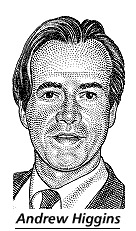At 11:20 a.m. on Feb. 5, Lars Hedegaard answered his door bell to an apparent mailman. Instead of receiving a package, however, the 70-year-old Danish historian and journalist found himself face to face with a would-be assassin about one third his age. The assailant shot him once, narrowly missing his head. The gun locked, Hedegaard wrestled with him, and the young man fled.
 Police search the area around Lars Hedegaard's residence after the assault. |
When the New York Times belatedly bestirred itself on Feb. 28 to inform its readership about the assassination attempt, it did not so much report the event itself but an alleged Muslim support for Hedegaard to express himself. As implied by the title of Andrew Higgins' article, "Danish Opponent of Islam Is Attacked, and Muslims Defend His Right to Speak," he mainly celebrates Danish Islam: "Muslim groups in the country, which were often criticized during the cartoon furor for not speaking out against violence and even deliberately fanning the flames, raised their voices to condemn the attack on Mr. Hedegaard and support his right to express his views, no matter how odious [emphasis added]." This theme pervades the piece; for example, Karen Haekkerup, the minister of social affairs and integration, is quoted pleased that "the Muslim community is now active in the debate."
 Andrew Higgins, author of a "New York Times" article about Lars Hedegaard. |
Secondarily Higgins delegitimizes Hedegaard, my topic here. In addition to the snarky "no matter how odious" reference, Higgins dismisses Hedegaard's "opinions" as "a stew of anti-Muslim bile and conspiracy-laden forecasts of a coming civil war" and claims the Dane has "fanned wild conspiracy theories and sometimes veered into calumny."
These characterizations of Hedegaard's work are a vicious travesty. A few specifics:
1. What Higgins airily dismisses as Hedegaard's "opinions" is in fact a substantial oeuvre in several academic books and articles laden with facts and references dealing with Islamic ideology, Muslim history, and Muslim immigration to Denmark. Those books include:
I krigens hus: Islams kolonisering af Vesten [In the House of War: Islam's colonization of the West] (with Helle Merete Brix and Torben Hansen). Aarhus, Hovedland, 2003
1400 års krigen: Islams strategi, EU og frihedens endeligt [The 1400 Year War: Islam's strategy, the EU and the demise of freedom] (with Mogens Camre). Odense, Trykkefrihedsselskabets Bibliotek, 2009
Muhammeds piger: Vold, mord og voldtægter i Islams Hus. [Muhammad's girls: Violence, murder and rape in the House of Islam] Odense, Trykkefrihedsselskabets Bibliotek, 2011
Hedegaard's major articles include:
"Den 11. september som historie" [September 11 as history] in Helle Merete Brix and Torben Hansen (eds.), Islam i Vesten: På Koranens vej? Copenhagen, Tiderne Skifter, 2002.
"The Growth of Islam in Denmark and the Future of Secularism" in Kurt Almqvist (ed.), The Secular State and Islam in Europe. Stockholm, Axel and Margaret Ax:son Johnson Foundation, 2007
"Free Speech: Its Benefits and Limitations" in Süheyla Kirca and LuEtt Hanson (eds.), Freedom and Prejudice: Approaches to Media and Culture. Istanbul, Bahcesehir University Press, 2008
"De cartoon-jihad en de opkomst van parallelle samenlevingen" [The cartoon jihad and the emergence of parallel societies] in Hans Jansen and Bert Snel (eds.), Eindstrijd: De finale clash tussen het liberale Westen en een traditionele islam. Amsterdam, Uitgiverij Van Praag, 2009
 Lars Hedegaard with Daniel Pipes, Copenhagen, March 2007. |
And, as someone who has written two books on conspiracy theories, I judge Hedegaard's writings innocent of that intellectual sin.
2. Higgins ascribes to him "forecasts of a coming war"; but these are not his forecasts, only his reporting what Islamist texts and spokesmen themselves predict and advocate.
3. Higgins writes that Hedegaard "for several years edited a mainstream Danish daily, Information, is a major figure in what a study last year by a British group, Hope Not Hate, identified as a global movement of 'Islamophobic' writers, bloggers and activists whose 'anti-Muslim rhetoric poisons the political discourse, sometimes with deadly effect'."
"Islamophobia" is a silly neologism intended to vilify anyone who criticizes Islam or even Islamism.
As for "sometimes with deadly effect": that is applied to the whole group of 100 organizations and individuals in the Hate not Hope listing, not to Hedegaard individually. Higgins nastily insinuates that Hedegaard is responsible for deadly attacks on Muslims when, in fact, he was the victim not the perpetrator of an attack. (Hope not Hate, by the way, lists both the Middle East Forum and me in its Counter-Jihad Report; it flatters me as the "Powerhouse behind the international counter-jihadist movement.")
In conclusion, it's not "a stew of anti-Muslim bile and conspiracy-laden forecasts" but "a cocktail of sensible critiques and unsettling analyses." Higgins has written a stew of shoddy aspersions of a brave, distinguished, and accomplished writer with whom I co-authored an article "Something Rotten in Denmark?" in 2002 and who is currently a colleague at the Middle East Forum.
Shame on Higgins for this article and shame on the New York Times for publishing him.
Mr. Pipes (DanielPipes.org) is president of the Middle East Forum. © 2013 All rights reserved by Daniel Pipes.
